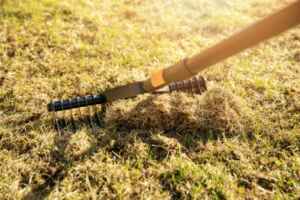Who likes having the ugly multi-colored grass during the Spring and Summer months. I do not want to be that Neighbor. What is the secret to making it greener and healthier? One way to make sure your grass is green is to make sure you’re mowing it regularly and at the correct height. The general rule of thumb is to never cut more than 1/3 of the grass blade at one the envy of the neighborhood.
The answer to this question depends on a number of factors, including the type of grass you have, the climate you live in, and the amount of sunlight your lawn receives. However, there are a few general tips that can help you achieve a luscious, green lawn.
What Can Make My Grass Awesomely Green?
No one does not long for grass that is lush and green, which is the talk of the neighborhood. However, achieving this might be a difficult task. To make your grass as green and healthy as possible, you must take measures to make it greener.
Here are some tips for making your lawn greener:
 You Need To Thatch Your Yard
You Need To Thatch Your Yard
Most people do not know what thatching is. Thatch is essentially a layer of dead grass and trash that covers the soil of your lawn. It’s plants that haven’t fully decomposed, such as stems and stolons, rhizomes, roots, and other things.
- If your grass has a ½-inch thatch layer, then you need to do something about it.
- A thatch build-up will make your yard more susceptible to pests and diseases.
- The thatch layer can also prevent water and nutrients from getting to the roots of your grass.
- You can accomplish that by using a rake and some elbow effort if you’re dealing with half an inch of thatch.
- If your grass has a thick covering of around ¾ inch or more, however, you’ll want to book a scarifying machine from your local garden center.
Scarifying is a process that will remove the thatch layer by slicing it off the top of your lawn. The big advantage of scarifying is that it also aerates your soil at the same time, which is important for grass health.
Fertilize Your Lawn
If you want your grass to be green and healthy, you need a lawn fertilizer. The best time to fertilize your lawn is in the spring when the grass is actively growing.
- You should also fertilize your lawn in the fall, to help the roots recover from the summer heat.
- When selecting a fertilizer for your lawn, you should choose one that contains nitrogen, phosphorus, and potassium.
These are the three essential nutrients that all plants need to grow. You can find fertilizers that contain these nutrients in a variety of different forms, such as granules, liquids, and spikes.
 Water Your Lawn Properly
Water Your Lawn Properly
If you want your grass to be green, you need to water it properly, especially after you fertilize your lawn. Watering your lawn too much will cause the roots of your grass to suffocate and can lead to fungal diseases.
- On the other hand, if you don’t water your lawn enough, the roots will dry out and your grass will turn brown.
- To ensure that your grass gets the right amount of water, you should follow a regular watering schedule and water your lawn deeply.
- This means that you should allow enough time for the soil to absorb all of the moisture before watering it again.
If possible, try to water your lawn during the early morning hours, when the sun is not as strong. This will help to minimize evaporation and will allow the water to penetrate deeper into the soil.
Mow Your Lawn Regularly
Mowing your lawn regularly is one of the best ways to keep it looking its best. When you mow your lawn, you should always use a sharp blade.
- A dull blade will tear the grass, rather than cut it, which can damage the blades and make your lawn more susceptible to disease.
- You should also mow your lawn at the correct height. The general rule of thumb is to never cut more than 1/3 of the grass blade at one time.
- If you cut any more than this, you can cause stress to the grass and damage your yard.
- As a general rule, you should mow your lawn weekly in the summer and every two weeks in the fall.
- During other times of the year, try to cut it every three weeks or so.
To keep your grass looking its best, follow these tips on how to make your grass green. By following these simple tips, you can have a beautiful, green lawn that you can be proud of.
Why Do I Need To Fertilize My Lawn?
Most homeowners are not knowledgeable about landscaping, and browsing the aisles of fertilizer at the local garden center may have left you more confused than ever. What exactly do those three digits on the bags stand for? Is there a difference between liquid and granular fertilizers for your grass to worry about?
Finding the ideal grass fertilizer should not be difficult. That’s why we’re going through all of the fundamentals so you know what to look for when buying fertilizer. By the time you’ve finished reading, your next trip to the garden store will be a breeze.
Fertilizer
- It is a chemical or natural substance that is applied to the soil to promote fertility and provide food for plants.
What are the nutrient needs for my lawn?
The best approach to figuring out what nutrients are missing from your turf’s soil is to have a soil test done. You may do an at-home soil analysis or send a sample to your local cooperative extension office.
You need to get an at-home testing kit.
- An at-home soil test will allow you to get quick answers from the comfort of your own home. It will show you whether your soil is acidic, neutral, or alkaline, as well as its nitrogen (N), phosphorus (P), and potassium (K) content.
There are so many different types of soil test kits available, including chemical color dyes, pH test strips, and an electronic pH meter. Remember to study the kit’s instructions since they may differ from what is stated below. Read up on the differing kits and decide which one you like.
Chemical color dyes
- You’ll make many soil and water combinations with this test method.
- The chemical dyes will correspond to the three major nutrients (nitrogen, phosphorus, and potassium).
- After you add the chemical dyes to each combination, the water will change color.
- You’ll then choose a color for each combination based on the color chart that comes with the kit.
pH test strips
- A litmus test is a simple way to check acidity.
- A strip of paper is dipped into a solution of soil and water.
- The color of the strip will alter depending on the pH level.
- Match the hue of the strip to that shown in the color chart to determine the pH level.
Electronic pH meter
- To evaluate pH, you insert the probe of the electronic meter into the soil-water mixture.
You might want to try the laboratory soil test
Although at-home soil test kits are convenient and provide fast results, they are not as reliable as a laboratory soil test.
- A soil test done at a local cooperative extension offers numerical nutritional values, such as parts per million (ppm), rather than generic word-based answers.
- A home soil test only assesses the levels of N, P, and K.
You will need to know the best N-P-K fertilizer mix for your lawn in order to get a lab test. To learn how to gather a soil sample, contact your local cooperative extension office.
 How much fertilizer should I buy?
How much fertilizer should I buy?
Since you know what your soil needs let’s calculate how much fertilizer you’ll need. The majority of lawns require 1 pound of nitrogen per 1,000 square feet.
- Let’s assume that the soil test revealed a 30-0-10 fertilizer product that is 3% nitrogen, 0% phosphorus, and 10% potassium.
- Calculate the amount of nitrogen your lawn needs
- To do this, you’ll need to know how big your lawn is. For example, let’s say that your lawn is 4,000 square feet.
- You would need (4,000 sq ft)(1 lb/1,000 sq ft) = 4 lbs of nitrogen
You’ll then divide the number of pounds you need by 3% to find out how many bags of fertilizer you’ll need. In this case, we get (4 lbs)(100%)/(3%) = 133.3 . This means that you’ll need to buy 134 pounds of 30-0-10 fertilizer.
Conclusion
While a green lawn requires some effort, it’s well worth it when you’re the envy of your neighborhood. Continuing to follow the steps given are key to keeping your lawn looking great year-round. Whether you opt for an at-home soil test or a laboratory test, the first step is to become familiar with your turf’s nutrient needs. Once you know what nutrients are missing, it becomes easy to calculate how much fertilizer to buy. With a healthy amount of fertilizer and proper watering, your grass will be the perfect shade of green in no time. You are on your way to a healthier and more beautiful lawn.

